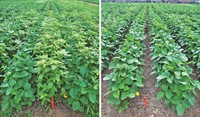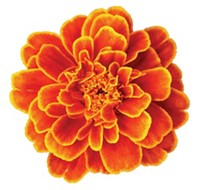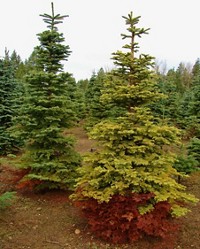Advertisement
Grab your lab coat. Let's get started
Welcome!
Welcome!
Create an account below to get 6 C&EN articles per month, receive newsletters and more - all free.
It seems this is your first time logging in online. Please enter the following information to continue.
As an ACS member you automatically get access to this site. All we need is few more details to create your reading experience.
Not you? Sign in with a different account.
Not you? Sign in with a different account.
ERROR 1
ERROR 1
ERROR 2
ERROR 2
ERROR 2
ERROR 2
ERROR 2
Password and Confirm password must match.
If you have an ACS member number, please enter it here so we can link this account to your membership. (optional)
ERROR 2
ACS values your privacy. By submitting your information, you are gaining access to C&EN and subscribing to our weekly newsletter. We use the information you provide to make your reading experience better, and we will never sell your data to third party members.
Pesticides
Herbicides emerge as an unexpected ally in the war on invasive plants
Scientists and conservationists are leveraging chemical tools to be efficient and targeted in natural ecosystems
by XiaoZhi Lim, special to C&EN
April 12, 2022
| A version of this story appeared in
Volume 100, Issue 13

Last June, Adam Knox and his crew boarded a helicopter in Maui, Hawaii, with an air gun and a small canister of capsules resembling paintballs. But instead of paint, these capsules contained the herbicide triclopyr. The crew was hunting miconia.
Originally from Central and South America, the miconia tree has consumed large swaths of land in Hawaii, eliminating biodiverse native forests as it proliferates. Nothing grows under the dark shadow of its meter-long leaves. Dubbed the “purple plague” of Hawaii, miconia is so widespread that it is no longer controllable on the Big Island, Knox says. But Maui still has a chance to escape the plant’s effects, so Knox and his colleagues on the Maui Invasive Species Committee, a team of researchers that identifies and manages invasive plants and animals in Hawaii, regularly scout the island for lone, young specimens.
On the June mission, the team found one individual 415 m east of the last-sighted plant. Knox took aim and shot triclopyr paintballs from the helicopter at the budding miconia, killing it before it could mature and spread.
Herbicides may have been developed to help farmers control weeds and boost agricultural yields, but they have become a vital tool for land and water managers battling invasive plants that threaten ecosystems and their benefits. Unlike native vegetation adapted to growing on Hawaii’s steep cliffs, miconia does not have deep roots, so it collapses easily during strong winds and rains or if it gets too top-heavy. These uprootings cause soil erosion, destroying watersheds and the clean drinking water that they provide.

“We manage with extreme prejudice against this species,” says James Leary, an invasive plant scientist at the University of Florida. He developed the paintball technique, called Herbicide Ballistic Technology, while at the University of Hawaii at Manoa.
Every plant invasion is unique and requires a tailored response. But herbicides are generally more cost effective and yield results faster than other methods for combating invasive species, such as mechanical removal, burning, or introducing a biological predator. Using herbicides against invasive plants is not without controversy, though, particularly in aquatic settings. Even when applied in small quantities and, as much as possible, directly onto target plants, herbicides may still harm nearby nontarget vegetation.
Yet the threats that invasives pose to ecosystems are so severe—and so urgent—that they often outweigh the collateral damage from herbicide treatments. Invasive plants and animals are the third-biggest threat to biodiversity worldwide, after land-use changes and species exploitation, according to a 2020 report commissioned by the World Wide Fund for Nature. Hawaii and other biodiversity hot spots with many endemic species are particularly at risk.
Meanwhile, projects to rebuild ecosystems can use herbicides to suppress invasive plants while native species begin to recover. Worldwide, herbicides were used in 42.3% of the restoration interventions reported between 2000 and 2019 in scientific literature (J. Appl. Ecol. 2020, DOI: 10.1111/1365-2664.13656).
“I would prefer of course not to use any chemical method to control invasive species,” says Emanuela Weidlich, an ecologist at the Federal University of Santa Catarina who led the herbicide-use survey. “But sometimes, it’s nearly impossible when we think about large-scale restoration.”

Formidable foes
Plants considered to be invasive grow faster, larger, and wider than native vegetation, outcompeting them for resources like space, food, and light. Often, invasive species offer little to no nutrition for wildlife and also remake habitats in detrimental ways.
Drew Kerr and his colleagues at the San Francisco Estuary Invasive Spartina Project have spent almost 20 years using the herbicide imazapyr to kill an invasive species of spartina, or cordgrass, as part of an effort to rehabilitate tidal marshes and mudflats that support a wide range of wildlife. The invasive cordgrass is a vigorous hybrid between a desirable species native to California and a foreign one from the US East Coast.
When the project began in 2000, “the threat to the native cordgrass was that the hybrid would extirpate it entirely, would drive it extinct,” Kerr says. The invasive cordgrass grows not only faster but also at a lower soil elevation in the estuary than the native cordgrass, covering mudflats that need to be bare to host bottom-dwelling creatures like bivalves or crustaceans, which serve as food for migratory birds.
A big constraint for Kerr’s team is the estuarine soil, sediment that developed in coastal areas from decades of tides bringing silt and mud in and out. Kerr likens it to an “old growth” soil. “Digging it is just not feasible without doing major damage,” he says. Plus, cordgrass grows from rhizomes, underground stems that can sprout new plants if conservationists leave just a small piece in the soil. “Herbicide is the least [environmentally] impactful tool to treat this plant and is the most feasible in many cases as well,” Kerr says, noting that some infestations spanned hundreds of hectares continuously.
Instead of pulling invasive cordgrass out manually, the team applies imazapyr directly onto the invasive cordgrass’s foliage, either by walking right up to accessible plants with a backpack sprayer or by gliding out on airboats to reach remote clumps during low, receding tides. Native cordgrasses interspersed with the invasive species may die as well, Kerr says, but these occurrences are infrequent. More importantly, pickleweed, a cornerstone native species that more commonly mingles with the invasive cordgrass, can tolerate imazapyr, likely because it is a succulent. That finding was fortunate, he says, as it has allowed the team to proceed with herbicide treatment rapidly. Today, 99% of the cordgrass in the San Francisco Estuary is native; there was almost none in some areas when the project started.

Herbicides are most valuable for reaching otherwise inaccessible, isolated plants before they mature into reproductive colonies, as with miconia in Hawaii, the University of Florida’s Leary says. With its shallow roots, small miconia can be easily pulled up on a hike, Knox says. The problem is the plant spreads far beyond where humans can tread in Hawaii.
Miconia fruit is a favorite of birds, which deliver miconia seeds into steep, rough terrain like the sides of cliffs, Knox says. Meanwhile, miconia is self-fertile, so a single plant escaping into uninfected areas can start a new colony once it comes of age, within 4 years—a “perfect storm of an invasive species,” Leary says. A fully grown plant could produce some 5 million seeds per year.
So, while at the University of Hawaii in 2006, Leary began collaborating with the company Nelson Paint to formulate herbicide into paintball-sized capsules to precisely attack young miconia plants among otherwise desirable vegetation. They chose triclopyr because it was effective against woody plants like miconia, and its oil-based formulation was compatible with the paintball casings. Since operations began in 2012, Leary, Knox, and their colleagues have killed about 26,000 individual plants, rescuing over 17,000 hectares of forested watershed.

Aquatic invasions
In Florida, Leary now works to control aquatic invasive plants. Aquatic plants are more difficult to manage than terrestrial plants mainly because they spread out underwater, whereas terrestrial plants usually cover a somewhat flat area. In the water, “you’re moving in three dimensions,” Leary says.
One of the toughest and most economically damaging aquatic invasive plants is hydrilla, which is now found in over 30 US states. Between 2008 and 2015, Florida spent $66 million trying to fight off the plant. Hydrilla clogs waterways and slows the movement of water. Its dense foliage reduces light penetration and dissolved oxygen levels in the water, hurting fish populations. What’s more, hydrilla reproduces in four ways, including sprouting from tiny, broken fragments of its stem. For this reproductive ability, hydrilla was named after Hydra, the regenerating nine-headed serpent in Greek mythology.
In the late 1980s, the herbicide fluridone was successfully deployed against the plant, Leary says. Fluridone inhibits carotene synthesis in plants, which in turn causes sugar-producing chlorophyll to rapidly degrade in sunlight. But overreliance on fluridone made its effectiveness short lived. “In a matter of 10 years, large populations of hydrilla developed resistance,” Leary says.
Enter florpyrauxifen-benzyl, a promising herbicide that could help manage fluridone-resistant hydrilla, as well as other aquatic invasives, like the Eurasian water milfoil and floating heart. The compound was originally developed to control weeds in rice paddies, says Mark Heilman, who leads aquatic technologies at SePRO, a specialty chemical company.
Florpyrauxifen-benzyl kills fluridone-resistant hydrilla with a different mechanism than fluridone: it stimulates out-of-control growth in cell walls, which later disrupts the plant’s ability to distribute sugars made in its leaves to its other cells, Heilman says. SePRO started working on a formulation of florpyrauxifen-benzyl called ProcellaCOR in 2010. The product can be applied directly to plant foliage or in the water that an invasive plant occupies, he says.
Even though aquatic herbicides need to meet stringent regulatory criteria, such as having a short degradation half-life, treating aquatic plants with herbicides has met significant backlash, particularly when the treatments are added to the water, Leary says. In response to public outcry about previous in-water herbicide treatments, Leary and his colleagues instead attempted large-scale mechanical harvesting of hydrilla in Florida’s Lake Tohopekaliga in 2019. Unsurprisingly, it was more expensive to manage hydrilla this way, Leary says—about three times as much as using herbicide.
But a bigger constraint was the reach of the aquatic harvester used to cut the hydrilla. In water deeper than a couple of meters, “you’re leaving a 2 ft [0.6 m] stubble of live plants that are rooted in the sediment,” Leary says. “Instead of getting 8–16 months of suppression, you’re getting 1–2 months.” Meanwhile, in shallower waters, harvesters indiscriminately cut all vegetation, including desirable plants.
Understanding the biology of an invasive plant can help minimize the use of herbicides, says Rob Richardson, a weed scientist at North Carolina State University. Treating hydrilla colonies each year before they form reproductive, dormant buds, for instance, is vital for long-term management.
To further improve the efficiency of applying herbicide treatments, Richardson and his colleague Steve Hoyle designed a small boat that can treat aquatic plants with herbicide on its own. The system, dubbed ADAPT for Aquatic Delivery Autonomous Precision Technology, can reduce the risks involved for people applying herbicides, including chemical exposure and boating accidents. The boat could be remote controlled from shore, or it could travel to infected areas and apply herbicide by itself after it has previously mapped occurrences of invasive plants.
Unmet needs
Chemical tools have proved invaluable for managing invasive species thus far, but “there is always room for improvement,” Kerr says. Formulations could become safer, and active ingredients could become more selective to their specific targets.

To mitigate public concern about the use of synthetic herbicides in natural settings, Weidlich, the ecologist at the Federal University of Santa Catarina, suggests that new herbicides could be based on natural products from plants known to exert suppressive effects on their neighbors.
In Hawaii, Knox and his team hope to extend the Herbicide Ballistic Technology to other chemicals, as ecologists are fighting over a dozen invasive species. Grasses, for example, are not susceptible to triclopyr, Knox says. And glyphosate, which is effective against an invasive grass in the area, has a water-based formulation and is therefore not compatible with paintball casings.
But the researchers see a huge obstacle to creating new chemical products for land and water management: preserving wildlife habitat and natural areas doesn’t come with obvious monetary returns on investment the way improving crop yields might, Leary says. “If you don’t control weeds, you’re not going to get a crop to sell. But that’s a little harder to sell when it’s watershed protection or native habitat protection.”
Advertisement
While the value of ecosystem services is slowly gaining recognition, in the meantime, the best thing to do is simply not spread invasives. “The absolute lowest-impact and optimal strategy to dealing with invasive species is prevention,” Kerr says. Preventive measures can be as simple as making sure boots and clothes are clean before traveling from one forested area to another, or emptying out the water in boats and cleaning them of any plant fragments before leaving a body of water.
As for the invasive plants that have already arrived and are spreading fast, there is no time to waste in protecting natural areas. “I would argue [herbicides] are the most environmentally responsible tool that we have, relative to the alternative,” Leary says.

XiaoZhi Lim is a freelance writer. A version of this story first appeared in ACS Central Science: cenm.ag/herbicide.





Join the conversation
Contact the reporter
Submit a Letter to the Editor for publication
Engage with us on Twitter